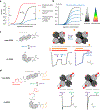Optical control of neuronal ion channels and receptors
- PMID: 31289380
- PMCID: PMC6703956
- DOI: 10.1038/s41583-019-0197-2
Optical control of neuronal ion channels and receptors
Abstract
Light-controllable tools provide powerful means to manipulate and interrogate brain function with relatively low invasiveness and high spatiotemporal precision. Although optogenetic approaches permit neuronal excitation or inhibition at the network level, other technologies, such as optopharmacology (also known as photopharmacology) have emerged that provide molecular-level control by endowing light sensitivity to endogenous biomolecules. In this Review, we discuss the challenges and opportunities of photocontrolling native neuronal signalling pathways, focusing on ion channels and neurotransmitter receptors. We describe existing strategies for rendering receptors and channels light sensitive and provide an overview of the neuroscientific insights gained from such approaches. At the crossroads of chemistry, protein engineering and neuroscience, optopharmacology offers great potential for understanding the molecular basis of brain function and behaviour, with promises for future therapeutics.
Figures





References
-
- Hille B Ionic Channels of Excitable Membranes. Third Edition Sinauer Associates, Inc. (2001).
-
- Lemoine D et al. Ligand-gated ion channels: new insights into neurological disorders and ligand recognition. Chem Rev 112, 6285–318 (2012). - PubMed
-
- Rask-Andersen M, Almen MS & Schioth HB Trends in the exploitation of novel drug targets. Nat Rev Drug Discov 10, 579–90 (2011). - PubMed
Publication types
MeSH terms
Substances
Grants and funding
LinkOut - more resources
Full Text Sources
Other Literature Sources

